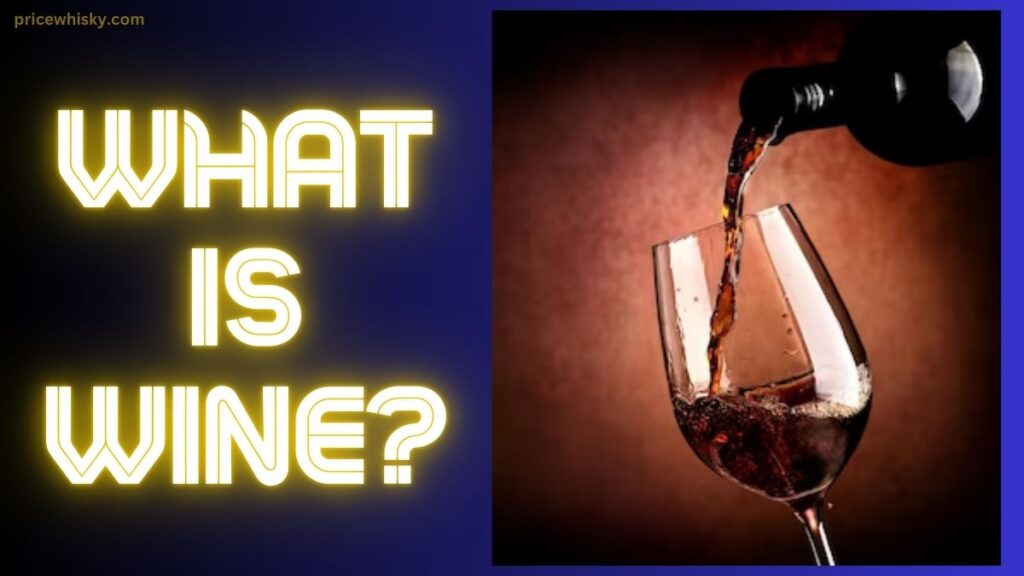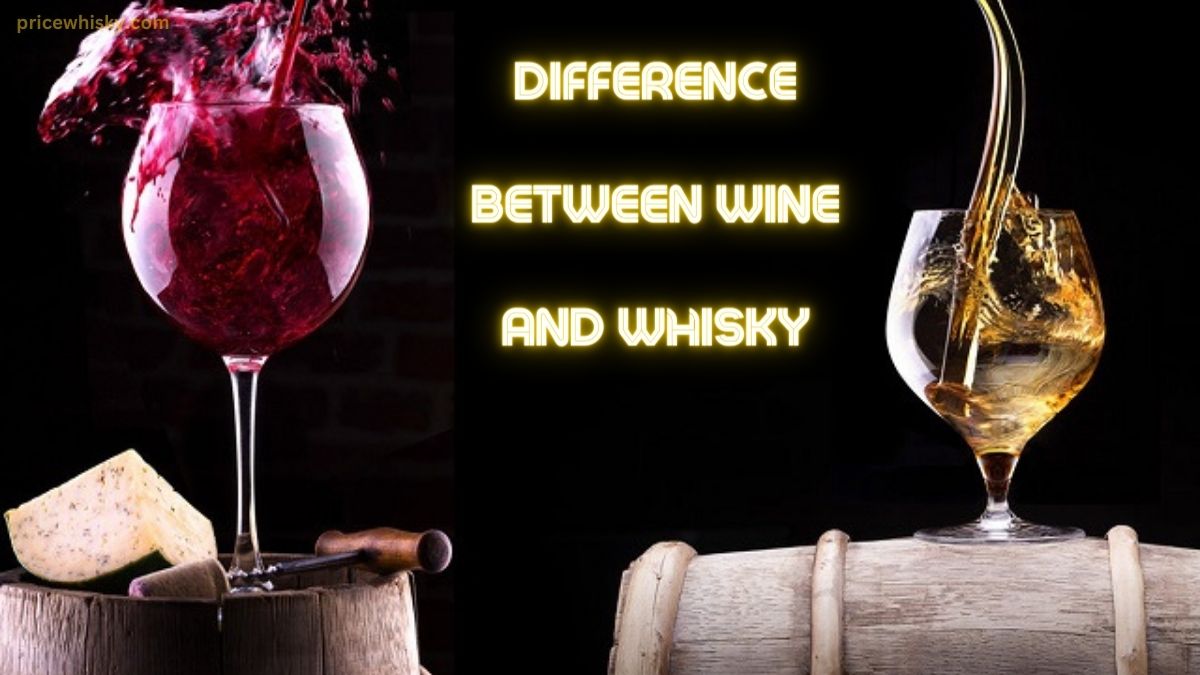Difference Between Wine and Whisky: Wine and whisky are two popular alcoholic beverages with distinct characteristics. While both are enjoyed by many, they differ significantly in their ingredients, production methods, flavors, and cultural significance. Understanding these differences can help appreciate the unique qualities of each drink. Let’s explore the contrasts between wine and whisky in more detail.
- Ingredients:
- Wine is made from fermented grapes or other fruits.
- Whisky is distilled from fermented grains like barley, corn, rye, or wheat.
- How They’re Made:
- Wine is produced by fermenting crushed grapes or fruits and then aging the liquid.
- Whisky involves mashing grains, fermenting the mash, distilling it, and then aging the resulting liquid in barrels.
- Alcohol Strength:
- Wine typically has a lower alcohol content, ranging from 9% to 16%.
- Whisky is stronger, usually containing 40% to 60% alcohol.
- Taste:
- Wine flavors depend on the type of grape or fruit, ranging from sweet to dry.
- Whisky flavors vary based on the grains used and aging process, ranging from smoky to sweet.
- Aging:
- Wine is aged in tanks or barrels for months to years.
- Whisky aging is crucial for flavor development, occurring in wooden barrels for several years.
- Cultural Importance:
- Wine is culturally significant in many regions, like France, Italy, and Spain.
- Whisky holds cultural importance in places like Scotland, Ireland, the USA, and Canada.
Difference Between Wine and Whisky
| Feature | Wine | Whisky |
|---|---|---|
| Definition | Wine is an alcoholic beverage made from fermented grapes or other fruits. | Whiskey or whisky is a type of distilled alcoholic beverage made from fermented grain mash. |
| Ingredients | Made from grapes | Can be made from barley, malted barley, rye, malted rye, wheat, buckwheat, and corn. |
| Production Process | Grapes are crushed into a machine, fermented, and then stored for a period of time. | Barley (or other base product) is first malted, then mashed, fermented, distilled, and aged. |
| Alcohol Content | Natural wines may exhibit a broad range of alcohol content, from below 9% to above 16% ABV, with most wines being in the 12.5%–14.5% range. Fortified wines (usually with brandy) may contain 20% alcohol or more. | Usually contains between 40-50% alcohol, however, it can be made to contain up to 96% alcohol. |
| Types | Red Wine, White Wine, Champagne, etc. | Single malt whiskey, Blended malt whiskey, Blended whiskeys, Cask Strength, Single cask, etc. |
| Produced in | Italy, France, Spain, America, Argentina, Chile, China, India, etc. | Scotland, England, Ireland, America, Canada, Australia, India, Denmark, Germany, etc. |
| 2024 Delhi Whisky Price Guide 2024 | Monkey Shoulder Whisky Price in Up |
| Cutty Sark Whisky Price in India 2024 | Chivas Regal price in Delhi 2024 |

What is Wine?
Wine, a beloved drink enjoyed by people for thousands of years, holds a special place in our culture and history. Its appeal lies not just in its delicious taste, but also in its nutritional value and intoxicating effects. [Difference Between Wine and Whisky]
Among alcoholic beverages, wine has had a significant impact on society. The exchange of wine between different cultures helped spread religious and philosophical ideas across Europe. References to wine can be found in religious texts, from the story of Noah and his vineyard to Jesus, often portrayed as a skilled winemaker.
Even today, wine remains important, symbolizing Christ’s blood in Catholic rituals. This tradition highlights the enduring significance of wine throughout history. In the past, a thriving wine industry indicated the prosperity of a nation, reflecting the sophistication of its society. It’s often said that Western civilization owes much to wine.
The various types of wine:
- Red Wine:
- Made from black grapes with their skins, seeds, and stems.
- High in tannin, leaving a dry taste. [Difference Between Wine and Whisky]
- White Wine:
- Made from both white and black grapes, but without the skins.
- Low in tannins, offering fresh, crisp flavors.
- Rosé Wine:
- Obtained by fermenting black grape juice with the skins for a short period.
- Generally low in tannins, often enjoyed for its light, sweet taste.
- Sparkling Wine:
- Carbonated wines made from both black and white grapes.
- Famous types include champagne, known for its bubbles and used in celebrations.
- Dessert Wine:
- Sweet wines enjoyed after meals, often paired with desserts.
- Includes fortified wines sweetened with added alcohol.
- Fortified Wine:
- Wine with added spirits like brandy during fermentation.
- Offers a range of sweet flavors and is often enjoyed with desserts.
The health benefits associated with wine:
- Glowing Skin:
- Wine applied topically can remove dead skin cells and leave the skin soft.
- Youthful Appearance:
- Compounds in wine, like resveratrol and flavonoids, combat aging and strengthen the immune system.
- Improved Cognitive Function:
- Red wine consumption is linked to sharper mental faculties, benefiting conditions like dementia and Alzheimer’s.
- Heart Health:
- Red wine helps control blood pressure, cleanses blood vessels, and prevents blood clots. [Difference Between Wine and Whisky]
- Acne Treatment:
- Antiseptic properties of red wine can reduce acne and provide a protective layer for the skin.
- Dandruff Solution:
- Applying red wine to the scalp can alleviate dandruff issues.
- Hair Care:
- Wine conditioners can strengthen hair and promote shine.
- Cancer Prevention:
- Compounds in wine, like resveratrol, help inhibit the growth of cancer cells.
- Improved Digestion:
- Moderate wine consumption can enhance digestive function and reduce ulcers.
- UV Protection:
- Flavonoids and amino acids in wine create a protective layer against UV rays, safeguarding the skin.

What is Whisky?
Whiskey is a distilled spirit crafted from fermented grain mash and aged in oak barrels. Its flavor primarily develops from the barrel aging process. Common grains used include corn, barley malt, rye, and wheat.
Originating in Scotland, whiskey produced there is known as Scotch whiskey or simply Scotch. Whiskey can be made from malt or barley, resulting in various blends like single malts, blended malts, and blended whiskeys, which combine multiple grains and malt whiskeys. [Difference Between Wine and Whisky]
the various types of whiskey:
- Scotch Whisky:
- Made in Scotland from malted barley or grains, aged in oak casks.
- Categories include single malt, single grain, blended malt, blended grain, and blended Scotch whisky.
- Irish Whiskey:
- Produced in Ireland, made from yeast-fermented grain mash of malted cereals, aged in wooden casks.
- Known for its smooth finish compared to Scotch.
- Bourbon:
- American whiskey primarily made from corn, aged in charred oak casks without additives.
- Slightly sweet with a reddish color from charred oak fermentation.
- Tennessee Whiskey:
- Produced in Tennessee, similar to bourbon but filtered through charcoal before aging.
- Known for its distinct flavor profile. [Difference Between Wine and Whisky]
- Rye Whiskey:
- Made primarily in North America, with at least 51% rye mash, aged in charred barrels.
- Offers a fruity and spicy flavor, popular in cocktails.
- Japanese Whisky:
- Produced in Japan, using double malted or peated barley, aged in wooden casks.
- Known for its dry, smoky profile, available as single malt or blend.
| Red Knight Whisky Price in Delhi 2024 | Teachers Whisky Price in Delhi 2024 |
| Red Label Price in MP 2024 | Teacher whisky price in India 2024 |
Health benefits associated with whiskey:
- Weight Management:
- Whiskey contains minimal fat and sodium, aiding in digestion and metabolism, potentially supporting weight loss efforts.
- Nutritional Value:
- A low-calorie beverage, whiskey provides carbohydrates without fat, offering a modest source of energy. [Difference Between Wine and Whisky]
- Cold Relief:
- Whiskey mixed with hot water, lemon juice, and honey can provide relief from cough and cold symptoms.
- Antioxidant Properties:
- Rich in antioxidants like ellagic acid, whiskey may help fight cancer cells and reduce the risk of certain cancers.
- Heart Health:
- Whiskey may help prevent blood clots, reduce bad cholesterol, and support cardiovascular health. [Difference Between Wine and Whisky]
- Memory Enhancement:
- Ethanol content in whiskey keeps brain neurons active, potentially improving memory and reducing the risk of dementia.
Taste Difference in Wine and Whisky
| Aspect | Wine | Whiskey |
|---|---|---|
| Alcohol Content | Generally lower, ranging from 9% to 16% ABV | Higher, typically between 40% to 50% ABV, but can vary |
| Taste | Varies widely depending on type and origin | Crisper for white wine, with flavors like citrus, stone fruit, berries, or floral notes. Red wines can range from light-bodied with berry flavors to rich-bodied with dark fruit or spicy notes |
| Smoky, salty, and malty for whiskey. Rye whiskey may have spicy notes, corn whiskey is sweeter, and Irish whiskey is known for its smoothness | ||
| Complement to Food | Enhances flavors of dishes, complements meals | Primarily enjoyed as a standalone drink |
| Production Material | Fermented grapes or fruits | Fermented grain mash, including barley, corn, rye, or wheat |
Difference Between Alcohol Percentage of Wine and Whisky
The alcohol content in wine is notably lower than that of whiskey. Wine typically falls between 5% and 25% alcohol by volume.
Regular wine averages around 11% alcohol, while fortified wine averages around 18%. Whiskey, on the other hand, usually contains between 40% and 50% alcohol by volume.
| Whisky Price in Karnataka 2024 | Paul john whisky price 2024 |
| Oaksmith Whisky price in India 2024 | White and Blue whisky price 2024 |
FAQs about Wine and Whisky:
- What are wine and whisky made from, and how are they different?
- Wine comes from fermented grapes or fruits, while whisky is distilled from fermented grain mash like barley, corn, rye, or wheat.
- How do the tastes of wine and whisky compare?
- Wine has various flavors, ranging from fruity to spicy, while whisky tastes smoky, malty, or sometimes spicy. [Difference Between Wine and Whisky]
- What’s the alcohol difference between wine and whisky?
- Wine has lower alcohol content, about 5% to 25% alcohol by volume, while whisky typically has 40% to 50% alcohol by volume.
- How are wine and whisky used in cooking?
- Wine complements dishes and enhances flavors, while whisky is enjoyed alone or mixed in cocktails.
- What are the cultural differences between wine and whisky?
- Wine is culturally significant in places like France and Italy, while whisky holds importance in Scotland and Ireland. [Difference Between Wine and Whisky]
Conclusion:
In this comparison of wine and whisky, we’ve seen how they’re made from different ingredients and offer distinct tastes. Whether you prefer the versatility of wine with meals or the boldness of whisky on its own, both offer enjoyment and cultural significance. [Difference Between Wine and Whisky]
Thanks For Visiting: pricewhisky.com
Whisky & Wine Lovers Also Read:
- ‘Taylor Swift ko bulao na’: Anant Ambani and Radhika Merchant wedding the internet advises calling Taylor Swift following reports of Drake, Adele, and Lana Del Rey’s performance.
- Netizens appear Vicky Kaushal and Katrina Kaif danced to the song Tauba Tauba by Bad Newz
- Anant Ambani and Radhika Merchant Wedding: Nita and Mukesh Ambani give cash, gold, and silver to fifty couples at the large-scale wedding; REPORT
- Kajal Aggarwal is enjoying her best friend wedding in an exotic setting, Gautam Kitchlu’s passionate forehead kiss is the highlight of the event.
- Watch as Sonakshi Sinha and Zaheer Iqbal, newlyweds, take selfies and enjoy “beautiful sunsets” while spending time by the pool.
